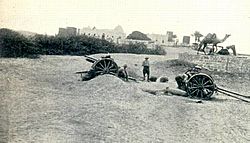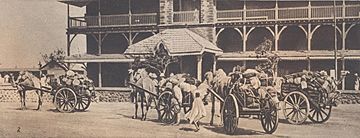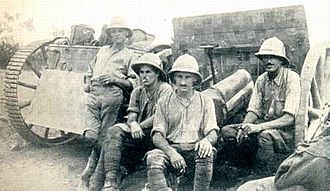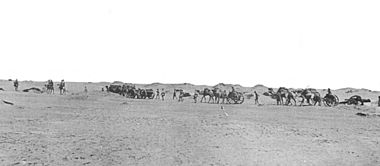South Arabia during World War I facts for kids
The campaign in South Arabia during World War I was a series of battles fought for control of the important port city of Aden. Aden was a key stop for ships traveling between Asia and the Suez Canal. The British Empire declared war on the Ottoman Empire on November 5, 1914. The Ottomans responded with their own declaration on November 11. From the start, the Ottomans planned to invade Britain's Aden Protectorate. They wanted to work with local Arab tribes to do this. The Ottomans had gathered many troops on Cheikh Saïd, a piece of land that sticks out into the Red Sea near Perim.
At the beginning of the war, Britain had one main force in the Aden Protectorate. This was the Aden Brigade, part of the British Indian Army. In November 1914, Ottoman forces from Yemen attacked Aden. But the Aden Brigade pushed them back. Even though the main fighting in South Arabia stopped after June 1916, the last Ottoman soldiers did not give up until March 1919.
Quick facts for kids Campaign in South Arabia |
|||||||
|---|---|---|---|---|---|---|---|
| Part of Middle Eastern theatre of World War I | |||||||
 A QF 15 pounder emplacement of B Battery, Honourable Artillery Company at Sheik Othman in 1915 |
|||||||
|
|||||||
| Belligerents | |||||||
Sulanate of Haushabi Ahl Haydara Mansur |
Beda Sultanate |
||||||
| Commanders and leaders | |||||||
|
|
||||||
| Strength | |||||||
|
14.000 Ottoman regulars Yemeni irregulars |
|||||||
| Casualties and losses | |||||||
| 500–1000 | 647 killed/missing 584+ wounded 32 captured |
||||||
Contents
Capturing Cheikh Saïd
The 29th Indian Brigade was a British Indian Army unit. It was on its way from India to Suez. But it was ordered to stop and capture Cheikh Saïd. Their mission was to destroy Ottoman forts, weapons, and water wells there.
On November 10, 1914, ships carrying three battalions of the 29th Indian Brigade arrived. They also had the 23rd Sikh Pioneers with them. The armoured cruiser HMS Duke of Edinburgh fired at the Ottoman defenses. This helped the troops land safely. They attacked the Ottoman positions and forced them to run away. The Ottomans left their field guns behind.
Sailors helped in the fighting. A naval team also helped destroy the Ottoman forts on November 11. After finishing their job, the British troops got back on their ships. They then continued their journey to Suez. The British decided not to go further inland at that time. So, the Ottomans kept some forces near the northern border of the Aden Protectorate.
Seven months later, the Ottomans took back Cheikh Saïd. They tried to land on the north coast of Perim Island. But the island's defenders, the 23rd Sikh Pioneers, successfully stopped this attack.
Fighting on Land
The Battle for Lahij
Lahij and its Sultan
In July 1915, an Ottoman force from North Yemen crossed into the Aden area. They moved towards Lahij. At that time, Lahij was a very important town in South Arabia. It was the capital of the Abdali Sultanate of Lahij. Lahij was in an oasis, surrounded by fertile land. It was a center for trade between Aden, which was a British colony, and the lands around it.
Before the war, Britain and Lahij were friends. Britain paid the Sultan money for using some land. They also protected him and his people from desert tribes who often raided them. The Sultan of Lahij was very loyal to Britain. He helped Britain even when other tribes turned against them. This made him a special target for the Ottomans and many nearby tribes.
The Siege of Lahij
The Sultan asked General D. G. L. Shaw, who led the Aden Brigade, for help. He said the Ottomans were coming to attack him. General Shaw sent the Aden Movable Column towards Lahij. The Aden Camel Troop went ahead to scout. They found a strong Ottoman force beyond Lahij, supported by many Arab tribesmen.
The Camel Troop went back to Lahij. There, they met the first part of the Movable Column. This group had 250 soldiers and two guns. They had moved forward in very difficult conditions. The heat was extreme, water was scarce, and moving through the sand was hard. The main part of the Column was delayed by transport problems and lack of water. It never reached Lahij.
The British soldiers in Lahij faced thousands of Ottoman troops and twenty guns. Also, thousands of Arab tribesmen joined the Ottomans. The British had only a few hundred men from the Sultan of Lahij's army. Many Arab helpers of the British left them at the worst moment. They took all their camels with them.
Fighting began on the evening of July 4. The Ottomans attacked the British lines many times, but each attack was stopped. The Ottoman artillery caused fires in Lahij. The British were also in danger of being surrounded by Arab horsemen. The Sultan was killed along with many of his men. Since the main Aden Column never arrived, the British pulled back on July 5. They lost three officers who were wounded. But the biggest loss was not in men, but in their reputation.
More Troops from India
After the defeat at Lahij, the British forces moved back to the Kawr. The Ottomans followed them and took over Shaikh Othman. This town was about two miles inland from Aden's harbor. Shaikh Othman used to be part of the Sultanate of Lahij, within the British protectorate. At this point, the Ottomans controlled almost all the land behind Aden, except for the area right around the colony itself. They had also taken back Cheikh Saïd and destroyed Lahij.
The Indian authorities decided to send more troops to Aden. Major-General Sir George J. Younghusband, a very experienced soldier, took command of the Aden Brigade.
On July 20, 1915, British troops surprised the Ottomans at Shaikh Othman. They completely defeated them and drove them out. About 50 to 60 Ottoman soldiers were killed or wounded. Several hundred men, mostly Arab tribesmen, were captured. The next month, a small group attacked an Ottoman post between Lahij and Shaikh Othman. The Ottomans were forced out of that town too. Another attack in a different area was also successful.
Reports said the Ottomans were getting ready to leave Lahij. In September, a British group moved towards Waht. There, they surprised 700 Ottomans with eight guns, supported by about a thousand Arabs. The Ottomans were pushed back, and Waht fell to the British. The British were helped by the cruiser HMS Philomel from the New Zealand Naval Forces.
Ottoman Claims of Victory
After this, there were many small fights between the Ottomans and Arabs, and the British. The British usually won. But they found it hard to hold onto land far inland. In early 1916, the Ottomans claimed that the British had been pushed back to Aden itself. They said the British were hiding under the protection of their warships and had not done anything for months.
Many of the Ottoman claims were greatly exaggerated, and some were completely false. In February 1916, a British politician asked for information about the fighting near Aden. The Secretary of State for India replied. He said the Ottoman claim of success was based on a fight on January 12. This was between a British scouting group and an Ottoman force near Shaikh Othman. The British lost one officer and 35 Indian soldiers killed. Four British and 35 Indian soldiers were wounded. The enemy lost about 200 killed and wounded. The British group was not destroyed or defeated. They simply pulled back when their mission was done.
Later, the Ottomans officially claimed a big victory in more heavy fighting around Shaikh Othman and Bir Ahmad. This was a complete invention. In January 1916, the Aden Movable Column went out to protect friendly troops. These troops were east of the Aden Protectorate. The Ottomans had sent forces to control them. The British column found the Ottoman force near Subar and defeated it. However, the overall situation was not good. So, in April 1916, it was decided that women should not be allowed to land at Aden without permission.
A Standstill in Fighting
The British-supported Arab Revolt began in the Hejaz in the summer of 1916. This made the Ottomans focus their attention away from Aden. The Ottoman troops who stayed in South Arabia went into defensive positions. The British built an eleven-mile-long defensive wall around Aden. They did not try to take back the land they had lost further inland. No major fighting with the British happened after 1916.
End of the Campaign
On October 30, 1918, the Ottoman Empire signed the Armistice of Mudros. This agreement meant they would surrender all their military bases outside of Turkey. However, this agreement did not immediately affect Ottoman forces in Yemen. Some commanders at first refused to surrender.
- Some Ottoman officials did not want to surrender to Britain. They thought this would make Britain too powerful in the region. Instead, they preferred to join Imam Yahya, who was creating the Mutawakkilite Kingdom of Yemen.
- Other Ottoman officials refused to give up their weapons without British forces present. They feared this would make Imam Yahya too strong.
- Twelve local leaders also wanted to be under British rule. This would let them stay independent in their own areas and get money. Imam Yahya, however, would make them pay taxes.
- Some Ottoman officials in Asir were still owed money. They demanded 100,000 pounds before surrendering. These forces surrendered at Al Luḩayyah (January 10, 1919), Al Hudaydah (by January 16), and Cheikh Saïd (January 19). Britain and the Idrisid Emirate of Asir paid the money. The Ottoman soldiers were then sent to Suez from Kamran Island on February 7.
- One leader, Elias Bey, did not surrender until he talked with an Ottoman messenger from Constantinople. This messenger arrived on January 13, 1919, and explained the situation.
- Another commander, Colonel Ghalib Bey, did not believe the Ottomans had signed an armistice. He refused to obey orders to surrender and wanted to fight to the death. His area fell to the Idrisid Emirate of Asir in March 1919.
On December 15, 1918, Britain quickly took back Lahij from Ottoman forces. By February 14, 1919, 3,100 Ottoman soldiers were still active in Yemen. By March 31, all Ottoman forces in Yemen had surrendered. Mahmud Tewfik Pasha, the Ottoman commander-in-chief in Yemen, was in Aden.
Using South Arabian Ports During the War
On October 18, 1914, a group of ten ships carrying the New Zealand Expeditionary Force sailed from Wellington. They were protected by the Japanese warship Ibuki. This group joined 28 other ships carrying the First Australian Imperial Force. This large group, with Ibuki and the Australian ship HMAS Sydney, crossed the ocean. The Japanese ship Chikuma was also patrolling the area. While Sydney was sent on a different mission and ended up in the Battle of Cocos, the rest of the ships reached Aden on October 25.
On November 9, 1914, a small group of German sailors was separated from their ship, the SMS Emden, during the Battle of Cocos. They sailed a small ship called the Ayesha to a Dutch port in Sumatra. From there, their leader, Lieutenant Hellmuth von Mücke, arranged to meet a German cargo ship. This ship took him and his men to the Ottoman city of Hodeida in Yemen. Once in Arabia, von Mücke and his men faced months of delays. They needed help from local Turkish officials to return to Germany. Finally, he decided to lead his men on a sea journey up the east coast of the Red Sea to Jiddah. In the end, von Mücke and 48 of his men made it back to Berlin.
When the Arabs of the revolt attacked the port of Jiddah in June 1916, they were supported by the seaplane carrier HMS Ben-my-Chree. This ship was based at Aden.
Taking Over Kamaran Island
On February 17, 1915, the British official in Aden, Brigadier William Crawford Walton, sent a message to the Government of India. He said that small boats carrying telegrams, mail, and money from Jiddah were reaching Ottoman headquarters in Yemen. He believed these boats needed to be stopped. He suggested taking over Kamaran Island with 200 men.
This idea was supported by the British Navy and other officials. But the leader in India was hesitant. He worried that local people might not agree. He also thought it might upset the Idrisi leader and be misunderstood by Muslims. He also feared it would weaken Aden's defenses, just when the Turks were advancing. On March 3, the order to take Kamaran was canceled. But when British intelligence suggested that some Germans were trying to sail from Africa to Arabia, the official in Aden asked for the 200 men again on March 7. The leader in India refused again on March 11.




